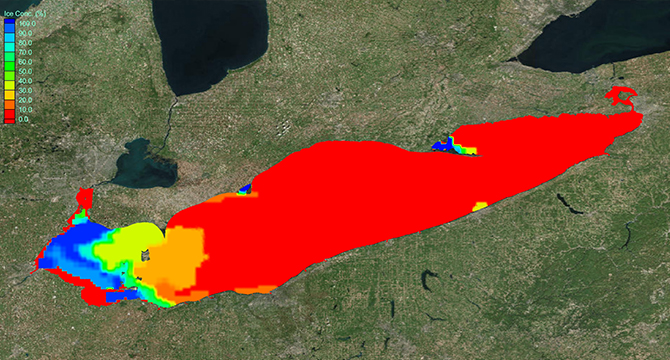The Great Lakes basin is an enormous watershed that includes the five Great Lakes and land in the surrounding eight states and the Canadian province of Ontario. Recently, we completed a Great Lakes coastal flood hazard analysis and mapping study for Lake Eire and Lake Ontario for the Federal Emergency Management Agency (FEMA) in order to produce updated Flood Insurance Rate Maps (FIRMS) for the coastal communities along the lakes. The study, which will allow for better estimates of flood hazards, is one of the most extensive coastal storm surge analyses to date for the Great Lakes, encompassing the coastal floodplains in each of the eight states that border the lakes.
The vision for this project has been to update National Flood Insurance Program (NFIP) products to increase public awareness of lake level variations and storm events, including potential storm surge and waves, and to enhance community resilience related to flood losses. The study was funded by FEMA's Risk MAP Program and was supported by the U.S. Army Corps of Engineers, the American Society of Floodplain Managers, and state partners.
Lake Erie: Understanding Storm Surge on the Shallowest Lake in the Great Lakes Basin
Together, the Great Lakes contain the largest volume of fresh water in the world. Of the five lakes, Lake Erie is the shallowest, warming more quickly in the summers and freezing over in the winter more frequently than the other lakes. Lake Erie is also known for high storm surges and "seiches," or disturbances or oscillations in the water level. For these reasons, the lake presents an interesting case for modeling coastal storms.
With FEMA's Great Lakes coastal analysis and mapping study complete, I supported Dr. Ali Farhadzadeh, assistant professor in the department of civil engineering at Stony Brook University and a former engineer with Dewberry, in pursuing an in-depth ice modeling analysis of Lake Erie in particular. This follow-up study was funded by Stony Brook University and led by Dr. Farhadzadeh.
Previous studies have shown that surface ice can directly alter interactions between lakes and the atmosphere, ultimately effecting water level, wave action, and water temperature. Our study focused on the simulation of extreme storm surge and waves under both ice-covered and ice-free lake conditions based on ice concentration data collected by the National Oceanic and Atmospheric Administration (NOAA). We used a wave height model (Simulating Waves Nearshore or SWAN), coupled with a storm surge model (Advanced Circulation Model or ADCIRC) as the basis for the study.

ADCIRC/SWAN model grid of Lake Erie
The investigation into ice impacts by Dr. Farhadzadeh found that the numerical models performed well in simulating the spatial and temporal variations of storm surge in Lake Erie, and that they clearly indicated that seiching motions are triggered following extreme surge events. By comparing model results for three storms with actual ice conditions and hypothetical ice-free conditions, we learned that surface ice has little effect on the storm surge at the peak of the storm when wind speed is highest. However, the difference between ice and ice-free storm surges can become large when wind speed is lower and the ice concentration is around 50 percent over a large area.

Ice concentration from a 2000 storm
The results, which show agreement between modeled storm surge and measurements in the presence of ice, helps to validate and support the first-time use of the models and methodologies used for the FEMA coastal flood hazard updates for the Great Lakes. The results also show that, regardless of future winter temperatures and the resulting ice concentration on Lake Erie, the peak storm surges from large wind events will remain the same, i.e. if climate change results in warmer winters and less ice, the surge and flooding risk from winter storms may remain the same as in the past. However, less ice may result in an increase in wave attack along the shorelines, which could impact shoreline erosion rates.
Dr. Farhadzadeh's study was recently published in the Journal of Coastal Research, Volume 33, Issue 6.